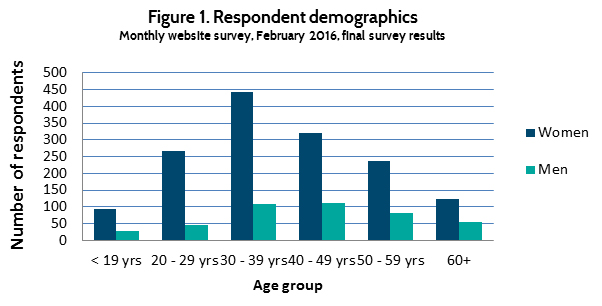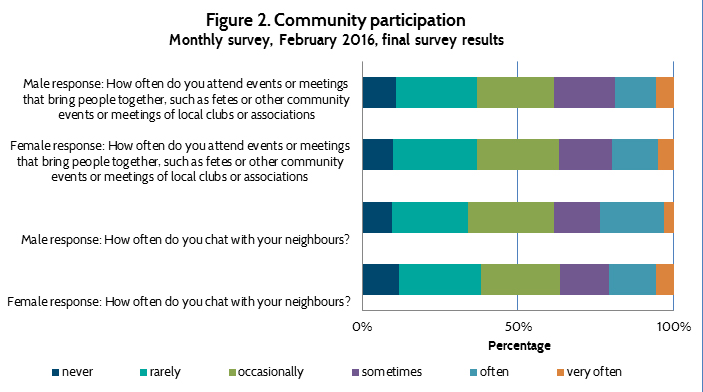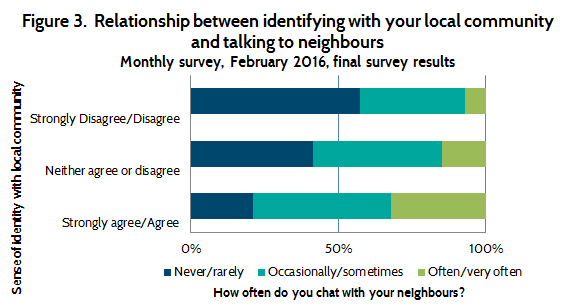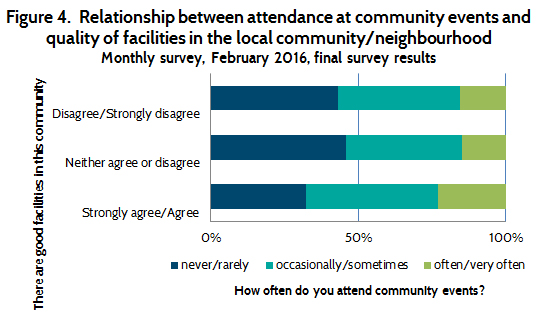Social participation has been linked to the success and wellbeing of individuals, families and communities across a range of studies, with high levels of participation linked to better physical and mental wellbeing. Social participation includes participation in both formal and informal groups, including involvement in community activities such as local events and clubs.
Introduction
Social participation has been linked to the success and wellbeing of individuals, families and communities across a range of studies, with high levels of participation linked to better physical and mental wellbeing. Social participation includes participation in both formal and informal groups, including involvement in community activities such as local events and clubs.
Particular factors have been found to be associated with increased community participation, including cultural background, socio-economic status, gender and age. Structural and organisational factors have also been identified, including ease of access, transport, availability, cost, location, engagement with local stakeholders, and the quality and safety of facilities.
The focus of February’s online survey was to find out whether the social participation of visitors to the Relationships Australia website was associated with their assessment of the adequacy of local parks, community facilities and the safety of their local neighbourhood, and whether they identified with their local community or neighbourhood.
The community participation questions selected for February’s online survey were adapted from the Household Income and Labour Dynamics Survey of Australia.
Previous research finds that…
- Community participation activities such as taking an active interest in current affairs; regularly socialising with household members, friends, extended family and neighbours; and taking part in organised community activities have been associated with improved wellbeing.
- 9 out of 10 people from main English-speaking countries and about 8 out of 10 people from other countries report attending a culture or leisure venue in the past 12 months.
- The most common forms of participation for older people include: sport or physical activity, with walking and lawn bowls being the most popular; and cultural venues such as the cinema, library, and the botanic gardens.
- Individuals who report feeling safe in a local park during daylight hours are between 6 and 7 times more likely to be frequent users of their local park.
- People with disabilities may be restricted in participation in some areas because of their particular activity limitation or impairment. Factors in their living environment, such as the attitudes of the people among whom they live, the constructed environment and the framing of social institutions may also act as barriers to participation
Results
More than 2,000 people responded to the Relationships Australia online survey in February 2016. Around four in five survey respondents (78%) identified as female, with more females than males responding in every age group (see Figure 1 below). Just under eighty-five per cent of survey respondents were aged between 20‑59 years, and almost 40 per cent of respondents comprised women aged between 30-49 years (inclusive).
As for previous surveys, the demographic profile of survey respondents remains consistent with our experience of the groups of people that would be accessing the Relationships Australia website.

Men and women reported similar levels of participation for the two activities identified by the survey questions (Figure 2). Just under two-thirds of men and women reported that they never, rarely or only occasionally attended events or meeting that bring people together, and a similar proportion reported that they never, rarely or only occasionally chatted with their neighbours. Around one-fifth of survey respondents reported that they often or very often attended events or meetings that bring people together, or chatted with their neighbours, similar to reports from the February 2015 monthly survey on aspects of community participation.

Survey participants were also asked a few questions about their local community facilities and the safety of their local neighbourhood. Respondents reported higher levels of agreement with statements that their community neighbourhood had good parks, playgrounds and facilities, than feeling a strong sense of identity with their local neighbourhood. While two-thirds of survey respondents agreed that it was safe for children to play outside during the day in their neighbourhood, almost one-sixth (16%) strongly disagreed or disagreed with this statement (Table 1).
|
Table 1. Assessment of the quality of facilities and safety of the local community/neighbourhood.
|
Strongly agree/agree |
Neither agree or disagree |
Strongly disagree/ disagree |
|
There are good parks, playgrounds and play spaces in this community/neighbourhood. |
76 |
13 |
12 |
|
There are good facilities in this community/neighbourhood (ie. community building, hall) |
59 |
26 |
16 |
|
It is safe for children to play outside during the day. |
65 |
21 |
15 |
|
You feel a strong sense of identity with your local community/neighbourhood. |
40 |
35 |
26 |
Survey responses revealed a strong relationship between social participation and whether people identified with their local community/neighbourhood, felt it was safe, and had good local parks and facilities. For example, people who were more likely to report a strong sense of identity with their local community or neighbourhood were also more likely to report that they often or very often chatted with their neighbours (Figure 3).

Similarly, survey respondents who reported there were good facilities in their local community or neighbourhood also reported more frequent attendance at community events (Figure 4).

References
Australian Bureau of Statistics (2008). Australian Social Trends, cat. no. 4102.0
Berry, H.L. & Shipley, M. (2009). Longing to belong: personal social capital and psychological distress in an Australian coastal region. Social Policy Research Paper No. 39. Canberra.
Eime, R, Harvey, J, Craike, M, Symons, C, and Payne W. (2013). Family support and ease of access link socio-economic status and sports club membership in adolescent girls: a mediation study, International Journal of Behavioural Nutrition and Physical Activity 2013, 10:50 http://www.ijbnpa.org/content/10/1/50
Wood, S, Bellis, M, Kelly, D, Hughes, K, Eckley, L and Chadborn, N. (2012). Use and perceptions of parks in Merseyside & Manchester